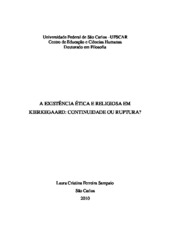Mostrar el registro sencillo del ítem
A existência ética e religiosa em Kierkegaard: continuidade ou ruptura?
| dc.contributor.author | Sampaio, Laura Cristina Ferreira | |
| dc.date.accessioned | 2016-06-02T20:12:15Z | |
| dc.date.available | 2010-06-16 | |
| dc.date.available | 2016-06-02T20:12:15Z | |
| dc.date.issued | 2010-04-07 | |
| dc.identifier.citation | SAMPAIO, Laura Cristina Ferreira. A existência ética e religiosa em Kierkegaard: continuidade ou ruptura?. 2010. 181 f. Tese (Doutorado em Ciências Humanas) - Universidade Federal de São Carlos, São Carlos, 2010. | por |
| dc.identifier.uri | https://repositorio.ufscar.br/handle/ufscar/4776 | |
| dc.description.abstract | The present study, based on the Kierkegaard s existential dialectics, intends to deal with ethical and religious existence in Kierkegaard, critically assessing the demands of religion and the limits of ethics. Upon establishing the relationship between the ethical and the religious, Kierkegaard using pseudonyms presents varied conceptions. In Fear and Trembling(1843) under the pseudonym Johannes de Silentio, he highlights the rupture between the ethical and the religious, showing that Abraham s story (Gn.22) holds a suspension of ethics; and under the pseudonym Vigilius Haufniensis, in the introduction to Concept of Anxiety (1844), he inserts, into his understanding of ethics, another distinction: between a first ethics , which encompasses Greek ethics as well as Hegel's speculative thinking, and a second ethics , established upon the Christian message, the concept of love to one s neighbor, demanded by a divine commandment, and the principle of ethical life. This second ethics is described a work titled Works of love , authored by way of his own name. In other words, it was attempted to clarify if there was a thorough exclusion or if it would be possible to think of an intrinsic reconciliation, due to some essential relationship between religious existence and ethical existence. | eng |
| dc.description.sponsorship | Universidade Federal de Minas Gerais | |
| dc.format | application/pdf | por |
| dc.language | por | por |
| dc.publisher | Universidade Federal de São Carlos | por |
| dc.rights | Acesso Aberto | por |
| dc.subject | Ética | por |
| dc.subject | Religião | por |
| dc.subject | Kierkegaard, Soren Aabye, 1813-1855 | por |
| dc.subject | Estádios da existência | por |
| dc.title | A existência ética e religiosa em Kierkegaard: continuidade ou ruptura? | por |
| dc.type | Tese | por |
| dc.contributor.advisor1 | Marques, Silene Torres | |
| dc.contributor.advisor1Lattes | http://lattes.cnpq.br/4822141288006918 | por |
| dc.description.resumo | A presente pesquisa, fundamentada na dialética existencial de Kierkegaard, pretende abordar a existência ética e religiosa, avaliando criticamente a exigência religiosa e os limites da ética. Ao colocar a relação entre o ético e o religioso, Kierkegaard com o uso da pseudonímia apresenta concepções variadas. Em Temor e Tremor (1843) sob o pseudônimo Johannes de Silentio, destaca a ruptura entre o ético e o religioso, onde a história de Abraão (Gn. 22) comporta uma suspensão da ética; e sob o pseudônimo de Vigilius Haufniensis, na introdução ao Conceito de Angústia (1844), insere, em sua compreensão de ética, uma outra distinção: entre uma primeira ética , que compreende tanto a ética grega, como o pensamento especulativo de Hegel, e uma segunda ética , estabelecida sobre a mensagem cristã - o conceito de amor ao próximo, ordenado pelo mandamento divino, e princípio de vida ética. Esta segunda ética é descrita em uma obra veronímica intitulada As Obras do Amor . Em outras palavras, procurou-se esclarecer se havia uma total exclusão ou se poder-se-ia pensar numa conciliação advinda de alguma relação essencial, intrínseca entre a existência ética e religiosa. | por |
| dc.publisher.country | BR | por |
| dc.publisher.initials | UFSCar | por |
| dc.publisher.program | Programa de Pós-Graduação em Filosofia - PPGFil | por |
| dc.subject.cnpq | CIENCIAS HUMANAS::FILOSOFIA | por |
| dc.contributor.authorlattes | http://lattes.cnpq.br/8635373522695785 | por |
